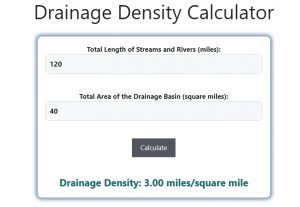About Drainage Density Calculator (Formula)
Drainage density is a crucial hydrological parameter that helps in understanding the characteristics of a drainage basin. It represents the total length of streams and rivers per unit area of the drainage basin, indicating how well the area is drained by its network of waterways. The Drainage Density Calculator allows users to easily compute drainage density, which can be vital for environmental studies, land use planning, and watershed management.
Formula
The formula for calculating drainage density is:
Drainage Density (DD) = Total Length of Streams and Rivers (RL) / Total Area of the Drainage Basin (BA)
How to Use
Using the Drainage Density Calculator is straightforward:
- Measure the Length of Streams and Rivers: Determine the total length of all streams and rivers in the drainage basin. This value should be in appropriate linear units (e.g., kilometers or miles).
- Determine the Area of the Drainage Basin: Measure the total area of the drainage basin. This should be in square units (e.g., square kilometers or square miles).
- Input the Values: Enter the total length of streams and rivers and the total area of the drainage basin into the calculator.
- Calculate: Click the calculate button to find the drainage density in appropriate units (e.g., kilometers per square kilometer).
Example
Suppose you have a drainage basin with the following characteristics:
- Total Length of Streams and Rivers (RL) = 120 kilometers
- Total Area of the Drainage Basin (BA) = 40 square kilometers
Using the formula:
Drainage Density (DD) = Total Length of Streams and Rivers (RL) / Total Area of the Drainage Basin (BA)
Substituting the values:
DD = 120 km / 40 km²
DD = 3 km/km²
Thus, the drainage density of the basin is 3 kilometers per square kilometer.

FAQs
- What is drainage density?
Drainage density is a measure of the total length of streams and rivers in a drainage basin divided by the area of that basin. - Why is drainage density important?
It helps in understanding water flow, erosion, and sediment transport, which are critical for managing water resources and environmental planning. - How is drainage density used in hydrology?
Hydrologists use drainage density to assess how effectively a drainage basin can transport water, which is important for flood management and ecosystem health. - What units are used for drainage density?
Drainage density is typically expressed in kilometers of stream length per square kilometer of drainage area (km/km²). - Can drainage density vary by region?
Yes, drainage density can vary significantly based on climate, topography, vegetation, and geology of the area. - What does a high drainage density indicate?
A high drainage density typically indicates a well-drained area with a dense network of streams and rivers, often associated with steep terrain or heavy precipitation. - What does a low drainage density indicate?
A low drainage density suggests a sparse network of waterways, which may occur in flatter areas or those with low rainfall. - How do you measure the length of streams and rivers?
The length can be measured using maps, satellite imagery, or geographic information systems (GIS). - How is the area of a drainage basin calculated?
The area can be calculated using topographic maps, satellite images, or GIS tools. - What factors can affect drainage density?
Factors include climate, land use, vegetation cover, soil type, and geological features. - Can drainage density be altered by human activity?
Yes, urbanization, deforestation, and agriculture can significantly change drainage density by altering natural waterways. - What role does drainage density play in flood management?
Understanding drainage density helps in predicting runoff and potential flooding in the area. - How does drainage density relate to soil erosion?
Areas with higher drainage density may experience more soil erosion due to faster water flow in streams and rivers. - Is there a standard range for drainage density values?
There is no universal standard, as values can differ widely depending on regional characteristics and hydrological conditions. - What tools can be used to analyze drainage density?
Geographic Information Systems (GIS), hydrological models, and remote sensing tools are commonly used for analysis. - How does vegetation affect drainage density?
Vegetation can slow down water flow, potentially reducing drainage density by absorbing water and increasing infiltration. - Can drainage density impact local ecosystems?
Yes, it influences habitat availability, water quality, and the distribution of plant and animal species in the area. - How can drainage density influence land use planning?
Knowledge of drainage density aids planners in making informed decisions about construction, agriculture, and conservation practices. - What is the relationship between drainage density and stream order?
Higher drainage densities may correlate with higher stream orders, indicating a more complex network of waterways. - Is drainage density useful for climate studies?
Yes, it can provide insights into the impacts of climate change on hydrology and water resource management.
Conclusion
The Drainage Density Calculator is a valuable tool for researchers, environmentalists, and planners. By providing a quick and accurate way to calculate drainage density, it helps in understanding the hydrological characteristics of a drainage basin. This information is crucial for effective watershed management, flood control, and land use planning, ensuring sustainable development while preserving ecological balance. Understanding drainage density can lead to better decision-making in water resource management and environmental conservation.